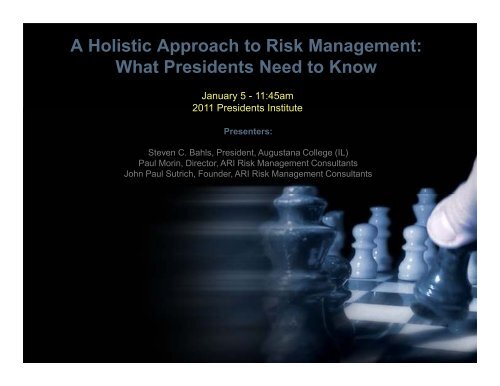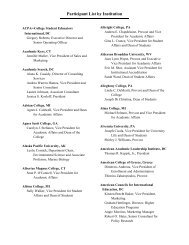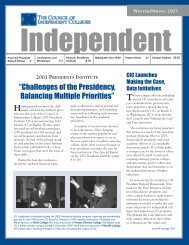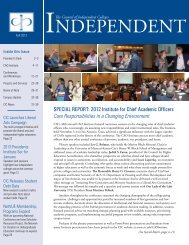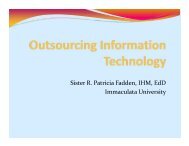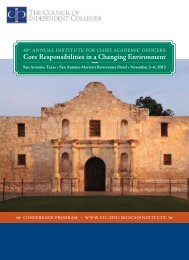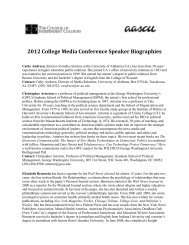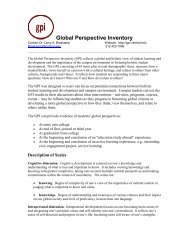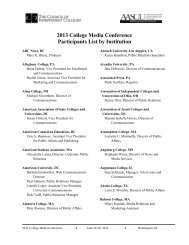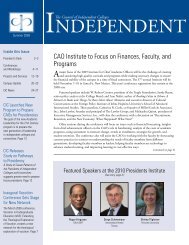A Holistic Approach to Risk Management - The Council of ...
A Holistic Approach to Risk Management - The Council of ...
A Holistic Approach to Risk Management - The Council of ...
Create successful ePaper yourself
Turn your PDF publications into a flip-book with our unique Google optimized e-Paper software.
A <strong>Holistic</strong> <strong>Approach</strong> <strong>to</strong> <strong>Risk</strong> <strong>Management</strong>:<br />
What Presidents Need <strong>to</strong> Know<br />
January 5 - 11:45am<br />
2011 Presidents Institute<br />
Presenters:<br />
Steven C. Bahls, President, Augustana College (IL)<br />
Paul Morin, Direc<strong>to</strong>r, ARI <strong>Risk</strong> <strong>Management</strong> Consultants<br />
John Paul Sutrich, Founder, ARI <strong>Risk</strong> <strong>Management</strong> Consultants
What is <strong>Holistic</strong> <strong>Risk</strong> <strong>Management</strong><br />
• Common Terms Are Enterprise or <strong>Holistic</strong> <strong>Risk</strong> <strong>Management</strong><br />
• It’s A Journey, Not A Destination<br />
• In Order To Address <strong>Risk</strong>s <strong>Holistic</strong>ally, You Must First:<br />
– Identify <strong>The</strong>m<br />
– Measure <strong>The</strong>m<br />
– Understand How <strong>The</strong>y Are Correlated<br />
– Develop A Common Unit <strong>of</strong> Measurement<br />
– Set Organization’s <strong>Risk</strong> Appetite<br />
• For <strong>The</strong> <strong>Management</strong> To Be <strong>Holistic</strong> and Enterprise-wide, Need<br />
Change In Culture<br />
2
<strong>Holistic</strong> <strong>Risk</strong> <strong>Management</strong><br />
<strong>The</strong> Experience at Augustana College<br />
• <strong>The</strong> Swiss Cheese Model<br />
• Creating a Culture <strong>of</strong> Safety<br />
– Reorganization <strong>of</strong> Safety Group<br />
• Examples<br />
– Injuries on the Athletic Field<br />
– Mental Health Issues<br />
• Other<br />
3
<strong>Holistic</strong> <strong>Risk</strong> <strong>Management</strong><br />
Builds on a Strong Strategic Foundation<br />
Strategic<br />
Planning<br />
4
Current <strong>Risk</strong> Transfer Analysis<br />
• <strong>Risk</strong> Map<br />
• <strong>Risk</strong> Pr<strong>of</strong>ile<br />
• <strong>Risk</strong> Costs<br />
Strategic<br />
Planning<br />
5
Operational <strong>Risk</strong> Analysis<br />
• Control <strong>Risk</strong><br />
• Employee <strong>Risk</strong><br />
• Systems <strong>Risk</strong><br />
• <strong>Risk</strong> Map<br />
• <strong>Risk</strong> Pr<strong>of</strong>ile<br />
• <strong>Risk</strong> Costs<br />
Strategic<br />
Planning<br />
6
Business <strong>Risk</strong> Analysis<br />
• Event <strong>Risk</strong><br />
• Credit <strong>Risk</strong><br />
• Legal <strong>Risk</strong><br />
• Control <strong>Risk</strong><br />
• Employee <strong>Risk</strong><br />
• Systems <strong>Risk</strong><br />
• <strong>Risk</strong> Map<br />
• <strong>Risk</strong> Pr<strong>of</strong>ile<br />
• <strong>Risk</strong> Costs<br />
Strategic<br />
Planning<br />
7
Market <strong>Risk</strong> Analysis<br />
• Funding risk<br />
• Product <strong>Risk</strong><br />
• Financial <strong>Risk</strong><br />
• Competi<strong>to</strong>r <strong>Risk</strong><br />
• Event <strong>Risk</strong><br />
• Credit <strong>Risk</strong><br />
• Legal <strong>Risk</strong><br />
• Control <strong>Risk</strong><br />
• Employee <strong>Risk</strong><br />
• Systems <strong>Risk</strong><br />
• <strong>Risk</strong> Map<br />
• <strong>Risk</strong> Pr<strong>of</strong>ile<br />
• <strong>Risk</strong> Costs<br />
Strategic<br />
Planning<br />
8
<strong>Holistic</strong> <strong>Risk</strong> Plan<br />
• Funding risk<br />
• Product <strong>Risk</strong><br />
• Financial <strong>Risk</strong><br />
• Competi<strong>to</strong>r <strong>Risk</strong><br />
• <strong>Risk</strong> Mapping<br />
• <strong>Risk</strong> Planning<br />
• <strong>Risk</strong> Structuring<br />
• Execution<br />
• Feedback Loop<br />
• Event <strong>Risk</strong><br />
• Credit <strong>Risk</strong><br />
• Legal <strong>Risk</strong><br />
• Control <strong>Risk</strong><br />
• Employee <strong>Risk</strong><br />
• Systems <strong>Risk</strong><br />
• <strong>Risk</strong> Map<br />
• <strong>Risk</strong> Pr<strong>of</strong>ile<br />
• <strong>Risk</strong> Costs<br />
Strategic<br />
Planning<br />
9
A Single Grain Of Sand On<br />
<strong>The</strong> Beach Of Organizational <strong>Risk</strong><br />
In Order To Be A Leading Institution:<br />
• You need <strong>to</strong> attract the best talent<br />
In Order <strong>to</strong> Attract and Retain Top Talent:<br />
• You should <strong>of</strong>fer competitive compensation and employee<br />
benefits<br />
In Order <strong>to</strong> Minimize Personal And Institutional Liability:<br />
• You must ensure those responsible are fulfilling their fiduciary<br />
duties and meeting available “safe harbor” requirements<br />
10
Legal Responsibilities <strong>of</strong> the Trustees<br />
Trustees must be faithful <strong>to</strong> the organization's mission, exercise<br />
reasonable care, and always act in the best interests <strong>of</strong> the organization.<br />
Basic Board Responsibilities<br />
1. Determine the Organization's Mission and Purpose<br />
2. Select the Executive<br />
3. Support the Executive and Review His or Her Performance<br />
4. Ensure Effective Organizational Planning<br />
5. Ensure Adequate Resources<br />
6. Manage Resources Effectively<br />
7. Determine and Moni<strong>to</strong>r the Organization's Programs and Services<br />
8. Enhance the Organization's Public Image<br />
9. Serve as a Court <strong>of</strong> Appeal<br />
10.Assess Its Own Performance<br />
Source: BoardSource<br />
11
A <strong>Holistic</strong> <strong>Approach</strong> <strong>to</strong> Employee <strong>Risk</strong><br />
Fiduciary Duty in Employee Benefit Plans<br />
• Exclusive Benefit: A fiduciary shall discharge his/her duties<br />
with respect <strong>to</strong> a plan solely in the interest <strong>of</strong> the participants<br />
and beneficiaries<br />
• Prudent Man: A fiduciary shall perform his duties with a<br />
high standard <strong>of</strong> care, skill, prudence, and diligence<br />
• Diversification Requirement: A fiduciary shall diversify the<br />
investments <strong>of</strong> the plan so as <strong>to</strong> minimize the risk <strong>of</strong> large<br />
losses, unless under the circumstances it is clearly prudent<br />
not <strong>to</strong> do so<br />
• Governance: Act in accordance with the governing Plan<br />
documents<br />
• Procedural: Utilize an appropriate process<br />
12
<strong>The</strong> Process:<br />
Comprehensive, Measurable & Documented<br />
Fiduciaries have the obligation <strong>to</strong> select and moni<strong>to</strong>r service<br />
providers <strong>to</strong> ensure decisions are made for the exclusive benefit<br />
<strong>of</strong> participants with the skill and prudence <strong>of</strong> an expert.<br />
404(a):<br />
Fiduciary Duties<br />
404(c):<br />
Protection for Participant<br />
Investment Decisions<br />
Investment Policy Statement (IPS)<br />
Broad Range <strong>of</strong> Investment<br />
Options<br />
Quantitative/Qualitative Fund<br />
Analysis<br />
Sufficient Investment<br />
Information/Education<br />
Prudently Select Investments<br />
Description <strong>of</strong> Fees and Expenses<br />
Consistently Implement Results<br />
404(c) Policy Statement and<br />
Employee Notice<br />
Independently Moni<strong>to</strong>r Investments<br />
Copy <strong>of</strong> Prospectus<br />
Defray Reasonable Expenses<br />
Description <strong>of</strong> Investment<br />
Alternatives and Fund Facts<br />
Follow Plan Document<br />
Voting and Tender Rights<br />
(if applicable)<br />
13
Retirement Plan Components To Analyze<br />
Cost<br />
Recordkeeping<br />
Technology Services<br />
Accounting<br />
Employer/Employee Reports<br />
Processing Payroll Deposits<br />
Quality Assurance Standards<br />
Billed Fees<br />
Investment <strong>Management</strong> Fees<br />
Asset Based Fees<br />
Revenue Sharing Disclosure<br />
Web-based Tools<br />
Loan/Withdrawal Processing<br />
Online Enrollment<br />
Plan Sponsor<br />
Fiduciaries<br />
Participant<br />
Plan Document SPD<br />
Discrimination Testing<br />
5500 Filings<br />
ERISA Resources<br />
Investment Philosophy<br />
Quantitative Analysis<br />
Qualitative Analysis<br />
Enrollment Materials & Meetings<br />
Individual Advice Solutions<br />
Participant Statements<br />
Compliance<br />
Communications<br />
Investment <strong>Management</strong><br />
14
Total Plan Cost<br />
<strong>The</strong> vast majority <strong>of</strong> <strong>to</strong>tal plan costs are paid for by participants<br />
through revenue sharing.<br />
Plan pricing will vary significantly based on:<br />
Plan Assets<br />
Participants<br />
Average Account Balance<br />
Service Requirements<br />
Administrative<br />
Fees<br />
+ Investment Fees + Plan Consulting = Total<br />
Plan<br />
Fees<br />
Cost<br />
Services <strong>to</strong> operate<br />
the plan:<br />
Recordkeeping,<br />
Trustee, Compliance,<br />
Communications<br />
All costs associated<br />
with managing the<br />
investments<br />
Advisory fees paid <strong>to</strong><br />
a registered<br />
investment advisor or<br />
commission paid <strong>to</strong> a<br />
broker.<br />
Paid for by plan<br />
sponsor or<br />
participant<br />
Always paid by<br />
plan participant<br />
Paid for by plan<br />
sponsor or<br />
participant<br />
15
Revenue Sharing<br />
Any investment fee or expense in excess <strong>of</strong> what is needed <strong>to</strong><br />
manage the assets in the plan.<br />
Shareholder Servicing:<br />
Revenue shared by the<br />
mutual fund company with<br />
the service provider.<br />
Sub-TA:<br />
Brokerage firms<br />
and mutual funds<br />
<strong>of</strong>ten contract<br />
recordkeeping and<br />
other services<br />
related <strong>to</strong><br />
participant shares<br />
<strong>to</strong> a third party<br />
called a subtransfer<br />
agent.<br />
Shareholder<br />
Servicing Fees<br />
Sub-Transfer<br />
Agency Fees<br />
12b-1<br />
Fees<br />
Investment<br />
<strong>Management</strong> Fee<br />
12b-1: Distribution<br />
expenses paid by mutual<br />
funds from fund assets.<br />
Includes commissions <strong>to</strong><br />
brokers, marketing<br />
expenses, and<br />
administrative services.<br />
Wrap Fee: Additional<br />
fees layered on <strong>to</strong>p <strong>of</strong><br />
<strong>to</strong>tal investment fees.<br />
Investment <strong>Management</strong>:<br />
Fees for management <strong>of</strong><br />
investment assets.<br />
Charges are a percentage<br />
<strong>of</strong> the assets invested and<br />
deducted from the<br />
investment return.<br />
16
Share Classes Defined<br />
Many mutual funds <strong>of</strong>fer the identical money manager with varying<br />
investment management expense options which afford revenue<br />
sharing opportunities.<br />
Name<br />
Description<br />
A<br />
Standard share class. Might include 12(b)-1 fee. No loads or sales charges.<br />
I<br />
B & C<br />
R1 – R5<br />
“I” = Institutional share class. Typically the next lowest expense class below<br />
“A”<br />
Applies only <strong>to</strong> very small plans (
Sample Cost Analysis With Revenue Sharing<br />
It’s imperative <strong>to</strong> create an “apples <strong>to</strong> apples” comparison <strong>of</strong> all the<br />
competing alternatives.<br />
18
Identified In <strong>The</strong> <strong>Risk</strong> Planning Process<br />
<strong>Risk</strong>: Retirement Plan Cost Oversight<br />
• Potential Allegations<br />
– Excessive fees<br />
– Failure <strong>to</strong> disclose<br />
– Prohibited transaction<br />
– Loss <strong>of</strong> investment return<br />
– Failure <strong>to</strong> moni<strong>to</strong>r appointed fiduciaries prudence & loyalty<br />
• Possible Financial Ramifications<br />
– Cost <strong>of</strong> investigation<br />
– Cost <strong>of</strong> defense<br />
– Penalties and fines (DOL)<br />
– Participant investment losses<br />
– Reputational<br />
19
What You Need <strong>to</strong> Know<br />
• Who is a fiduciary under ERISA Section 3(21) and coming July 2011<br />
Section 408(b)(2)<br />
• Have trustees taken the safe harbor step <strong>of</strong> forming and delegating<br />
authority <strong>to</strong> the appropriate committee <strong>to</strong> address retirement plan issues<br />
• Unless protected by a safe harbor, fiduciaries can be liable for the<br />
difference between actual investment returns and what the returns would<br />
have been in the absence <strong>of</strong> excessive fees.<br />
• Do the organization’s bylaws or other contracts indemnify the Plan<br />
fiduciaries for their service<br />
• Has the Plan or the organization purchased insurance <strong>to</strong> cover its<br />
indemnification obligations and/or the personal assets <strong>of</strong> the fiduciaries<br />
• Revenue sharing can be built in<strong>to</strong> the ERISA budget <strong>to</strong> <strong>of</strong>fset Plan costs such<br />
as fee and investment benchmarking, education, and communications.<br />
20
Overall Takeaways<br />
• <strong>Holistic</strong> <strong>Risk</strong> <strong>Management</strong> Is A Journey, Not A Destination<br />
• Change Will Not Happen Overnight<br />
• <strong>Approach</strong> To <strong>Risk</strong> Must Be Proactive And Interdisciplinary<br />
• Insurance Is Just One <strong>Approach</strong> To Addressing <strong>Risk</strong><br />
• A <strong>Risk</strong> Ignored Is A <strong>Risk</strong> Retained<br />
21
Presenter Contact Information<br />
Steven C. Bahls, President, Augustana College (IL)<br />
Office: 309-794-7208<br />
Email: stevenbahls@augustana.edu<br />
Paul Morin, Direc<strong>to</strong>r, ARI <strong>Risk</strong> <strong>Management</strong> Consultants<br />
Office: 617-423-0131 x30<br />
Email: pamorin@aririsk.com<br />
John Paul Sutrich, Founder, ARI <strong>Risk</strong> <strong>Management</strong> Consultants<br />
Office: 617-423-0131 x25<br />
Email: jpsutrich@aririsk.com<br />
22


